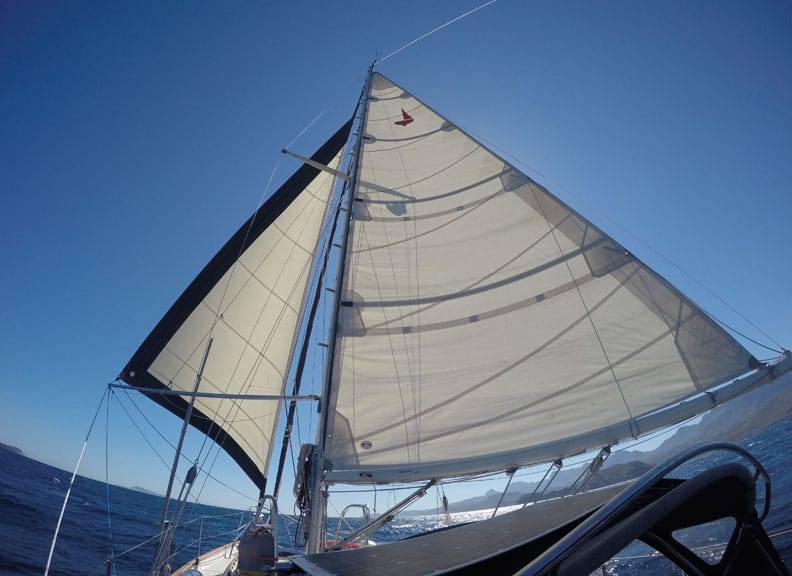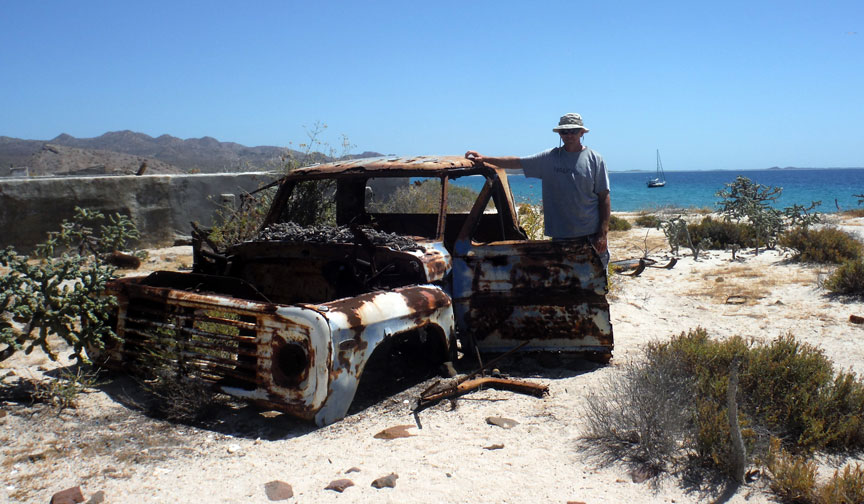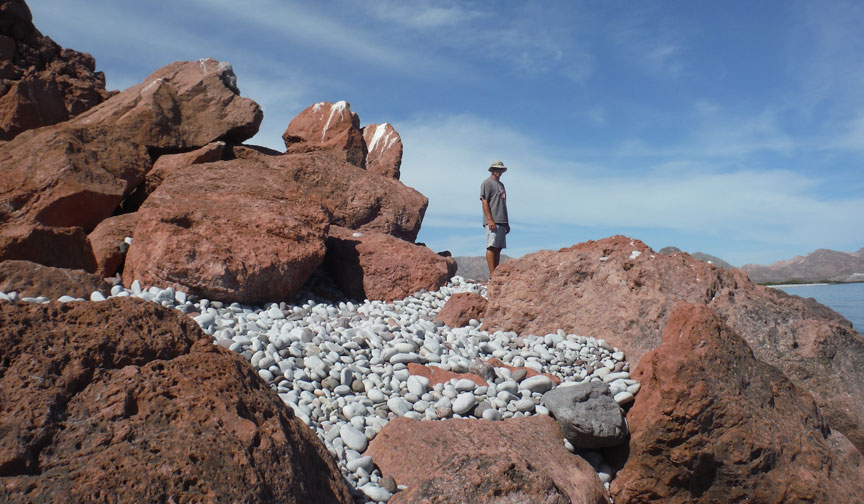This trip, with its consistent 10-15 knots of wind, has been our chance to improve our downwind sailing skills. Rarely do we get the precise wind angle for our direction to go wing-on-wing, but we’ve done it four days on this trip and for several hours each time. A brief definition of wing-on-wing (W.O.W.) is: flying the mainsail on one side of the boat and the jib on the other with the wind directly behind us, essentially pushing us forward.
Yesterday, we flew downstream from San Marte to Timbabiche wing-on wing, but I refused to let Brian put up the pole to keep the jib furled out. It was already far too windy and wavy for Brian to be crawling around on a convulsing, pitching deck unnecessarily. Without the pole though, it was very difficult to keep Indigo in check and stay at the necessary precise angle to the wind. Any little distraction in steering can result in a flapping and flailing jib. Let’s just say it was no leisurely Sunday drive.
WOW Event
So today, we hauled the pole up early, before it got too windy and the seas too gnarly. All the stars aligned for a superior WOW event: wave direction, wind direction and our direction to the next anchorage. It was a glorious thing.
For hours we enjoyed near perfect downwind conditions into the head of the San Jose Channel. As the wind had died the previous night, we started out with minimal waves and 5 knots of wind. And as the morning progressed, the wind slowly built to 15-17 knots but the slow uptick kept wave heights to middling. So the ride was just beautiful, like coasting a sled downhill. Unlike the previous day when Indigo was getting bullied about by the large waves (and me getting bandied about trying to steer her)… today she was expertly schussing down those seas like they weren’t even there.
The Pole is The Key when WOWing
Without the pole, the jib is constantly on the verge of collapsing because it wants to flip to the other side to align with the mainsail (my wandering steering doesn’t help). With the pole, the jib is held out in position whether it wants to be or not. Even though it requires some setup time, pole deployment balances the boat and thwarts the jib’s flip-flop tendency. This accomplished, I could darn near sail without paying attention. My true wind angle could vary anywhere from 180-140 degrees, as opposed to having to vigorously maintain 170 dead on without the pole. I could even venture over 10 degrees into the other side for a bit without gybing (don’t ask how I know this). Ah, but this is gibberish to you non-sailors. Basically, I could wander off unintentionally (my specialty) without dire consequences. What dire consequences? An accidental gybe.
What is a Gybe?
In sailing, there are essentially two types of turns, a tack and a gybe. You tack when your boat is driving into the wind; you perform a gybe when your boat is facing away from the wind. Tacking is way easier than gybing. Gybing can incur anxiety in even the most seasoned sailors - if not done right, disaster can ensue. There are three types of gybes: a ‘controlled gybe’, an ‘uncontrolled gybe’ and what I call a ‘semi-controlled gybe’.
Controlled Gybe
A purposeful turn, the sailor conscientiously controls the boom angle all the way through the turn. So there we are… picture the boom (that big, swinging stick perpendicular to the mast) hanging out over the water with its sail full. As the driver (me) carefully turns the boat towards the opposite wind angle, the mate (Brian) hauls the boom in (reeling it in with rope) until it hits almost amidships (aligning with the length of the boat). At this brief moment in time the wind angle is at exactly 180 degrees on our stern. If it’s calm, the mainsail flutters and the boom does a little waggle, deciding which way it wants to sail, and we can actually manhandle it over to the other side to reduce any load. But, if it’s windy out, forget it. We’d better be quick. As the boom crosses that 180 degree angle, the sail shakes loudly and the boom slams (hopefully just a little) to the opposite side as the wind suddenly poofs the sail. As the boat heels over, I quickly turn her even further and Brian lets the line out so the boom extends over the opposite side. That’s what happens when you do it right. It doesn’t always go so well.
Uncontrolled Gybe
An uncontrolled gybe occurs when the boom slams unchecked to the opposite side of the boat. This can result from a sudden switch in wind direction or a pushy wave. But most likely, someone (me) accidentally turned too far downwind and backwinded the sail before we are ready for a controlled gybe. Imagine that big, heavy boom swinging unrestrained from one side of the boat to the other, a pendulum swing of potentially 90 degrees or more (15 feet rather than 1 or 2 inches).
It can happen in the blink of an eye, but it feels like a slow-mo movie scene where the actor is just watching, wide-eyed and powerless to help. Noooooo! Before you know it, the boom has soundlessly whipped over your head and crashed to the other side with an earsplitting, lightning-bolt “SNAP”. A deep shudder reverberates up the attached mast, throughout the ship and deep into your gut (you are, after all, one with the boat). A palpable sensation, it’s enough to cause some pronounced bowel-shifting. Depending on your speed and how far and fast the pendulum has swung, enough momentum is in play here to break that boom-to-mast joint or snap the boom in half. High wind and wave conditions make that force even greater. If your body or head is in the way… good luck. We have never experienced a really bad gybe, but we have bungled a few over the years in light winds… and while we haven’t damaged anything, we still abhor gybing simply because we can’t help but anticipate potential catastrophe!
Semi-Controlled Gybe
This is pretty much the combo meal deal where I asked for 10 chicken nuggets but I only got 7 and complaining to the manager is pointless because, well, YOU are the manager. In turning across that 180-degree space, the driver turns too quickly and the mate can’t tighten up the boom all the way in time before it schwacks across at a 10-20 degree arc. Or…turn too slowly and a following wave can broadside the boat as the mate is in the process of bringing in the line, causing the boat to roll and gybe. Still a mighty crunch, but not AS BAD as it could have been had the mate not gotten that boom part-way tightened. Seven out of ten nuggets isn’t what I set out for, but at least I got some. Effectively a controlled gybe part of the way, uncontrolled the rest. Brian would still call this an uncontrolled gybe, partially tightened or not, but I prefer to note the difference. A 20-degree pendulum swing is a thousand times better than a 90-degree free swing. But either way… No Bueno. So what can you do?
The Preventer
Sounds like a super hero, eh? “THE PREVENTER – preventing accidental gybes worldwide. Wherever there be sloppy sailors, careless cruisers or ridiculous racers, THE PREVENTER precludes improper pointing.” While most boat parts are awarded some incongruous label, a preventer does exactly what it says. It prevents an uncontrolled gybe, reigning in that boom from flying about, willy nilly. A preventer is simply a line attached from the end or the middle of the boom to the deck, usually encompassing a ratcheting device which can be tightened as needed.
While we employ a preventer to stop full-on uncontrolled gybes, an inadvertent gybe will still cause the mainsail to become backwinded. Wind suddenly filling the sail from the opposing direction can cause excessive load. Depending on a lot of factors, your boom will prooobably stay in place; but this sudden load has caused preventer lines to snap (bad) thus resulting in an uncontrolled gybe anyway. Also, in heavy seas the rolling motion of a wave can cause a quick loosening in the preventer line and then a sickening ‘snap’ as the preventer whips the boom back into place. Despite its shortcomings, we usually sail with a preventer when sailing downwind and always when sailing wing-on wing.
Ok, enough sailing terminology …back to our lovely WOW Event…
The San Jose Channel
The San Jose Channel is notorious for its squirrely nature. It can be as fickle as a 2-yr-old… serene one minute, wailing the next. This 3 to 5 mile-wide slice of water runs between the Sierra Gigantas mountain range on the Baja peninsula and the 16-mile-long mountainous island of San Jose. Swooping tidal current can accelerate already high winds and seas. Previous experience with the Channel has ranged from benign flat water to mildly energetic. But we’d witnessed its howling rage from safe anchorage and were thankful we weren’t out there. Today, we miscalculated.
Let’s Keep Going!…Bad Idea
We had left at dawn, so about noon we’d gone almost 25 miles and were nearing San Evaristo, our original destination. But we’re feeling good, it’s early and Isla San Francisco is only another 12 miles away, we argued. Sailing a brisk 5-6 knots, Indigo rode at a perfect, comfortable angle to the slowly increasing waves… which we noticed… but ignored since our ship was effortlessly balanced. A little lulled into the lure of our perfect WOW sail continuing “as is”, we kept going. Those darn sea sirens must have been singing. Between that irreversible decision (@ noon) and our landing at Isla San Francisco (@ 2:30), the wind gods became angry….probably hangry, they didn’t have lunch yet I assume. Maybe next time I should throw some Cheez Whiz into the sea to calm them down.
Max Hull Speed
Passing San Evaristo, the wind quickly ticked upward from a manageable 15-17 knots… to 22 knots. Indigo was hauling butt at 7-7.5 knots, which by the way is hull speed, the theoretical maximum speed at which our particular boat is designed to go! Whitecaps snarled and hissed intermittently at our rear but there was no turning back. It would have actually been supercalifragilistically uncomfortable to do so, to bash into that mess. It was so windy, sailing wing-on-wing was no longer an option – too risky as the boat became unbalanced. Brian furled in the jib and went up on the lurching bow to take down the pole, no easy task in these now 5ft/4second seas. Sans jib, we were still racing down the channel at 6 knots under full mainsail alone.
27 Knots!
We try very hard not to sail in 27 knots; we just don’t go out when it’s forecasted over 20. But sometimes it sneaks up on you...like right now. I should have just turned off the wind indicator when I consistently started seeing 25-27 knots! Waves now broke behind us in a continuous hissy-fit, threatening to eat us for lunch. I gritted my teeth and opted not to look backward. Hand-steering down those short waves I felt like an Indy car driver – to focus so fully on not crashing is exhausting! Every 4 seconds our rear end lifted, our bow pointed at a daunting downward angle and Indigo was thrust forward like a plaything until it fell into the next trough. The boat handled it fine but at some point we were going to have to make a left turn into the anchorage and go beam-on to these frothing whitecaps. The stern waves were our friend now, helping to push us towards our goal, but as soon as we turned even a little they’d become the enemy.
Sailing Under Reefed Main Only
At 2pm, Brian put a reef in the mainsail and we continued to fly towards the island in 27 knots of wind but at a more controllable pace of 5 knots. We managed to (purposefully) get as close as physically possible to the island, skimming its west side a mere several hundred feet off shore. We are thankful for our accurate chartplotter and The Sea of Cortez Cruiser’s Guide; we had skimmed the island once before in calm waters and were thus confidant as to depths and rock obstructions so close to its edge. Once we made the pronounced left turn into the anchorage, this proximity reduced our time sailing beam-on to the breaking waves to mere minutes. Our skim-the-shore-wave-avoidance plan worked. Whew! We were in. That 8-hr WOW Event turned into quite a bit more WOW than expected, but we made it!
Lounge Lizards
We set the hook and promptly lazed like lounge lizards in the cockpit, resting our travel weary bones. We didn’t move from that heavenly spot for 3 days. I LOVE Isla San Francisco!
~ ~ ~ ~ ~ ~ ~ ~ ~ ~ ~ ~
Uncouth Charterboaters
OK, you yacht charterer guys. Just so you know… when you pee off the boat in the middle of the day, count on EVERYBODY seeing it.
So a charter catamaran anchors next to us with a couple families on board. We saw two different adult males pee off the boat no less than four times. During the day. In broad daylight. From the swim step. AND off the bow into the wind – Hey genius, never pee into the wind! I seem to recall some song lyrics about that. It’s not like we were intently watching them. We’d just happen to be looking out from the cockpit to see what the commotion is about or up on deck showering after a snorkel… and whammo, our eyes are inundated with the uncouth sight. Acckkk! Seriously? And if you think we were the ONLY ones who saw your tactless little display? Think again. In kayaking over to our trawler boat neighbor, the subject happened to come up. “Yeah! We SAW that too! What an idiot, peeing off the bow into the wind. And like no one could see him…” So, if you think no one is watching? Think again. And guess what language said charterers were speaking? French. Yah.




 RSS Feed
RSS Feed
